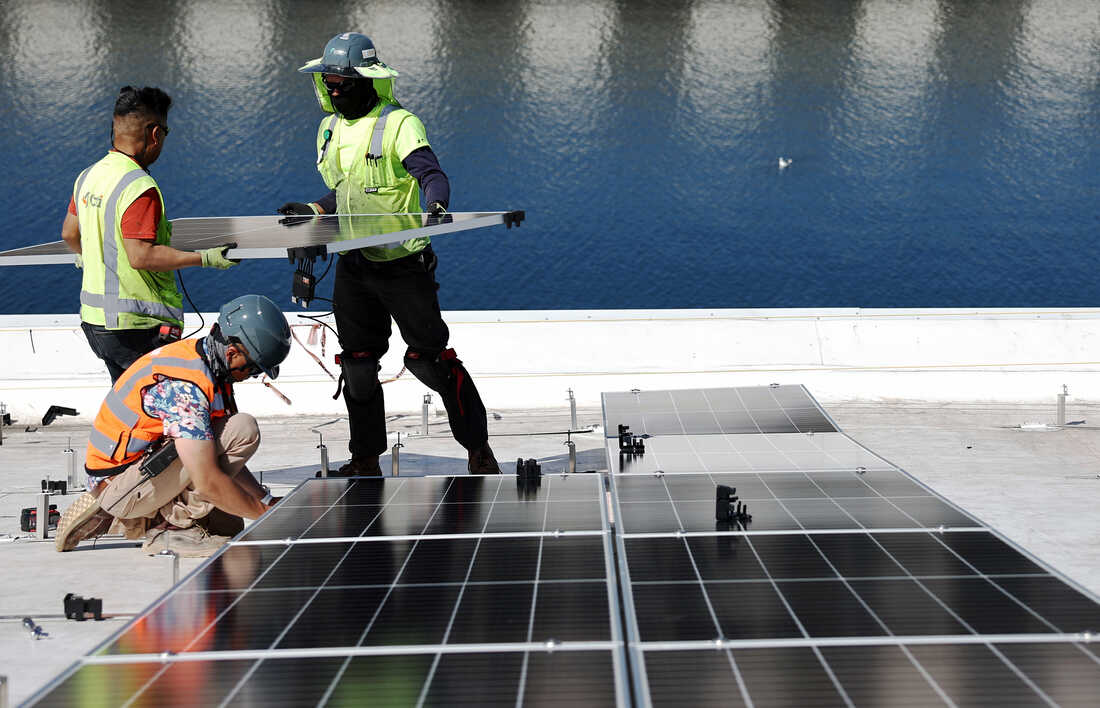
The U.S. could slash climate pollution, but it might not be enough, a new report says

Workers install solar panels at the Port of Los Angeles in California. Mario Tama/Getty Images hide caption
toggle caption
Mario Tama/Getty Images

Workers install solar panels at the Port of Los Angeles in California.
Mario Tama/Getty Images
The United States is poised to make much deeper cuts to the pollution that’s fueling global warming than it was even a couple years ago. That’s largely because of the billions of dollars the country is spending on green technologies through the Inflation Reduction Act (IRA), which Congressional Democrats passed last summer, according to a new report from Rhodium Group.
The research firm says that by 2030, the U.S. could lower its greenhouse gas emissions by 29% to 42%, compared to 2005 pollution levels. At the start of the Biden administration, Rhodium Group analysts said it looked like the country would only be able to cut its emissions by about a quarter, at most. The changed outlook reflects expectations that huge investments by the federal government will make things like renewable energy and electric vehicles a lot more affordable.
But big barriers still stand in the way. Companies that build wind and solar plants often struggle to get projects permitted by local governments because of public opposition. And there are long waiting lines to plug in power plants and batteries to the country’s electric grids. To make the kinds of emissions cuts that the Rhodium Group says are possible, the U.S. will have to at least match its best-ever year for wind and solar development, and it will have to do it year after year.
And even if everything goes right, it still won’t be enough to deliver on a pledge the U.S. made under the 2015 Paris Agreement to cut its emissions in half by the end of this decade. Meeting that target will require even more aggressive actions by states and the federal government, Rhodium Group says.
“You’re gonna need to figure out how to build out a whole bunch of wind and solar, get a bunch of electric vehicles on the road and that kind of thing,” says Ben King, an associate director in the firm’s energy and climate practice.
“The IRA is the push, the economic push that you need, and you just gotta clear the way for it and not let it encounter so many headwinds,” King adds.
A recent report from the United Nations warned that the world is running out of time to keep temperatures from rising to levels that could be catastrophic for many places. The Earth is already nearly 2 degrees Fahrenheit warmer than it was in the late 1800s, and it’s on track to exceed 5 degrees Fahrenheit of warming by the end of the century, according to the U.N. Beyond about 2.8 degrees Fahrenheit of warming, storms, heat waves and other climate impacts become far more destructive.
Limiting the rise in global temperatures will require an international response. But as the largest historical contributor to climate change, the U.S. “needs to lead that effort,” says Aiguo Dai, a professor of atmospheric and environmental science at the University of Albany.
“If the U.S. can start cutting down the emissions, steadily year over year, decade over decade, then we are on the right path to limit global warming,” Dai says.
However, scientists say time is of the essence. At the slow current pace countries are cutting emissions, warming is on track to trigger runaway impacts that could lead to permanent changes in the Earth’s ecosystems.
“If we cut it too [slowly], it could be difficult to avoid catastrophic warming in the near future,” Dai says.
Source: https://www.npr.org/2023/07/20/1189060785/u-s-could-cut-climate-pollution-but-it-is-still-short-of-paris-agreement-pledge















